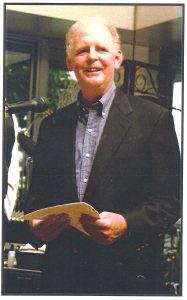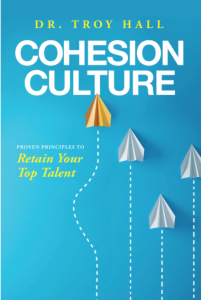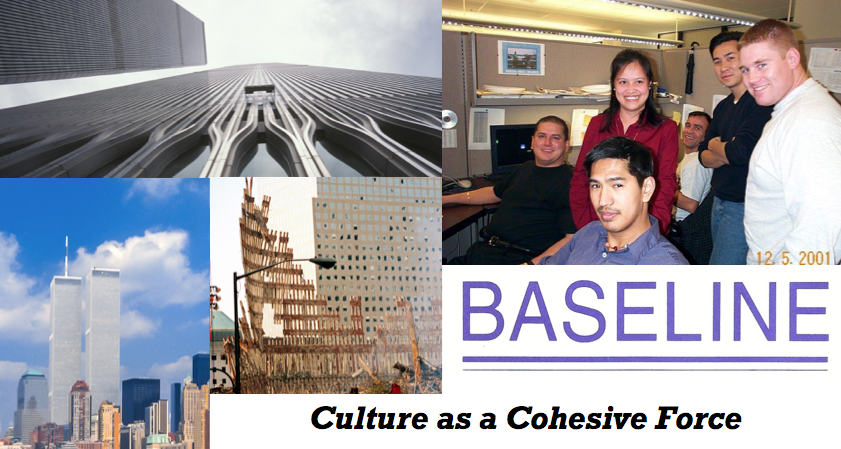As I penned my way through the drafting of Undaunted, a key business aspect of Baseline was becoming more and more apparent – that my colleagues’ reaction to the horrors on 9/11 and their resolve to quickly rebuild the company was driven by more than just human instinct. Despite the utter horror that rained down on the people of Baseline, I witnessed the company’s strong corporate culture take center stage.
To this day I remain deeply saddened over the loss of our four colleagues. However, I also credit the team-orientation, fortitude and caring attitudes of our associates for the lives saved that day and the incredible resurrection of the business within weeks of the tragedy. The team’s performance appeared to exceed the sum of its parts. Culture proved to be a cohesive force.
I use that word thanks to the efforts of Dr. Troy Hall, author of the bestselling title, Cohesion Culture: Proven Principles to Retain Your Top Talent. Following the release of my own book, I actively sought a more formal explanation for what I had experienced. In other words, I wanted to locate a formal prescription that not only helped explain the Baseline phenomenon, but that could also be used as a road map for today’s organizations. Cohesion Culture is such a script.
For those unaware, Baseline was headquartered on the 77th and 78th floors of Two World Trade Center where it employed 170 of its 225 people. Prior to 9/11, its rise as an entrepreneurial success was evident to many in the financial information industry. It had grown to $55 million in revenue in less than ten years providing a stock selection tool to asset management firms. While its clients embraced the product, its corporate culture was also renowned. Employee retention was north of 95%.

Rob Patterson – the founder and CEO of Baseline.
Undaunted, published in 2021, intertwines the story of 9/11 with the story of Baseline, and describes how its corporate culture helped influence its employees’ reaction to the events of the day and the months that followed. Leaders existed at all levels of the organization. Together, they refused to allow enormous adversity to stand in their way.
A Cohesive Culture
With 20/20 hindsight, I made some attempts within the pages of Undaunted to connect the dots of our Baseline environment to recent studies conducted by Harvard University and the consulting firm Accenture regarding winning corporate cultures. There seemed to be a fit. I was able to conclude that there was something special about this culture we enjoyed at Baseline. An insightful article written by Bill Koch in 1994 entitled “Teamwork, Technology and Talent” (aka The Three T’s) energized Baseline’s founder. It contained useful ideas for recruitment and team orientation. However, on a broader scale Corporate America wasn’t paying much attention to cultural methodologies at the time. There weren’t formal models for purposefully creating a fortified culture that would aid employee retention and performance improvement. Perhaps we were lucky to be on our particular path. Perhaps Rob Patterson had a crystal ball. Or, maybe he was just twenty years ahead of his time.
Whatever the reason, the culture at Baseline retained employees. It facilitated efficient inter-departmental relationships. It eliminated unnecessary and even duplicative work. Everyone understood the company’s values and its overall mission. Baseline’s associates knew they were critical to that mission, and exemplified a high level of loyalty. In retrospect and following Dr. Troy’s script, one might say the culture was – cohesive.
 At its core, Cohesion Culture seeks not only to make sure each employee is engaged, but that the sum of all employee engagements becomes interdependent. According to Dr. Troy:
At its core, Cohesion Culture seeks not only to make sure each employee is engaged, but that the sum of all employee engagements becomes interdependent. According to Dr. Troy:
“Individual engagement is not enough to create a truly successful culture of cohesion. What distinguishes a cohesion culture is the relational aspects of the talent within the organization and how employees think about and relate to one another. When a cohesion culture is in place, individuals are better able to relate to those in other parts of the organization, to those who may report to them, to their colleagues and peers, to their supervisors, and to those in the senior-most positions.”
Dr. Troy adds that the process of creating a Cohesion CultureTM “challenges leaders to create workspace environments where all employees have a sense of belonging, feel valued, and make a commitment to organizational success.” His book on Cohesion Culture can be found HERE.
Belonging | Value | Commitment
When I tie the notion of Dr. Troy’s cultural transformation back to my experience at Baseline, there are many parallels. To fully appreciate Baseline’s cultural environment that existed on September 11, 2001, a complete read of Undaunted is probably the best approach. However, here are some examples that quickly mirror Hall’s Cohesion CultureTM:
A Sense of Belonging: From Day 1, Rob Patterson preached the importance of team. Everyone mattered. In my book, I share my rather odd first day of employment: I was the 20th employee. Rob gave me my business cards as the new vice president and national sales manager and asked that I put them in my drawer and not use them. Huh? Why? He didn’t want others to overly perceive or worry about some official pecking order. Of course, over time as the team grew, we introduced organizational structure but kept the company perceptibly horizontal.
The aforementioned article by Bill Koch, who won the America’s Cup race as captain in 1993, proposed that three keys items should be considered to attain success whether at the helm of a sailing vessel or the head of a business unit. The Three T’s became Rob Patterson’s Rosetta Stone. The most important T was Teamwork. In fact, Koch’s article talked plainly about hiring people with the right attitude over those candidates who possessed overachieving attributes who might describe how they alone conquered the world. As such, and in addition to a standard recruitment regimen, Rob had all his managers utilize a personality profile from Caliper to help confirm “team oriented” individuals.
Feeling Valued: Every month, Rob Patterson would invite one member from each of the nine departments to lunch. Effective inter-departmental relationships were critical to Rob. It wasn’t just a social exercise – he actively sought feedback and wanted to ensure that Baseline’s mission and values were super transparent to everyone. He was also trying to demonstrate that every single employee was critical.
In fact, from the beginning he dubbed all his employees “associates.” He disliked the term “employee.” He felt employees worked for all the mediocre companies that dotted the globe. To Rob, associates saw themselves as family who cared deeply about each other and, most importantly, the clients. Rob also instructed his managers to “hire people smarter than you.” He wasn’t necessarily talking about IQ. He was speaking about specialized knowledge and experiences. Thanks to transparency, the associates of Baseline knew of this practice.
Regarding transparency, whenever we achieved a new milestone, often associated with client numbers, a Town Hall was held. Rob would reiterate the overall mission, and tie the recently achieved milestone to different aspects of organization from whence that achievement came – it was almost always a multi-departmental collaboration that was celebrated. Each associate would be presented with a plaque and a crisp Ben Franklin in an envelope to commemorate the achievement. Rank did not matter. Tenure did not matter. Everyone received the same acknowledgement.
Further, every associate’s annual performance review was held on the anniversary of his/her hiring date. We avoided the mad rush of a one-time-of-year-fits-all strategy of performance reviews, and took time with each evaluation. Every associate also knew their review was discussed openly at the Operations Committee’s monthly meeting to ensure fairness in both reviews and salary increases. Transparency was real. People felt valued.
Commitment: Rob Patterson was often fond of saying, “success in this business requires only two things: commitment to one another and client focus.” Clearly, there was more to Baseline than a cultural phenomenon. Many aspects of leadership, product strategy, and customer service were also strong contributors to success, but as I focused in on the team’s reaction to the events on 9/11 itself, as well as the days and weeks that followed, Baseline’s well-developed culture took center stage. The loyalty and commitment shown by management, and felt by all of Baseline’s associates, created a reciprocal effect.
On September 12, 2001, Baseline found itself without a headquarters, lacking key infrastructure, and mourning the loss of four wonderful colleagues. Further, to have any chance of resurrecting the business, many of us had to quickly relocate to Philadelphia – the location of our software development office and back-up data center. We would instantly need to be away from friends and family at a time when such comfort and support were incredibly important. From the pages of Undaunted:
“The distant city of Philadelphia suddenly became the center of our universe. In the first few days of a new world that felt post-apocalyptic, several managers had descended upon the City of Brotherly Love to chart a path forward… To have any chance of rebounding, we were going to need a very high level of cooperation… and, an overwhelming majority wanted to enthusiastically pitch in. Maybe some of it reflected a national pride not seen since post-Pearl Harbor enlistments. On the other hand, having witnessed the growth and maturation of our company culture, I believe the majority of enthusiasm stemmed from what was an absolute love of Baseline. The dividends of having a great company culture were about to pay off.”
Vice president of product management at Baseline, Ron Perez, nicely summed up the overall sentiment:
“It was loyalty to Rob and to one another that got us through it. People were willing to accept personal sacrifice. Those were wild and hectic times. Stress levels were so high, but everyone had a vested stake in our comeback. Our people identified with Baseline— what it meant to them personally and professionally. I’ve never seen that type of commitment across the board like that. It manifested itself after 9/11.”
Dr. Troy recently offered his thoughts on Baseline’s associates:
“It is no surprise that the people at Baseline responded favorably and with one accord to the challenges before them. They had built a collective group mentality giving a piece of their personal identity to form the overall group identity. When that happens the result in and of itself offers two significant benefits. First, when members truly believe they are both part of and included in the group or team, they will respond by protecting their group from any and all internal and external forces. They will work tirelessly to keep the group intact. Secondly, the group’s mentality is fueled to work toward mutually desired outcomes. In this way, the employees at Baseline aligned their individual values with corporate values, agreed to establish a form of group mentality, and became focused on surviving, which is what they deemed to be the mutual task at hand.”
Baseline’s culture was additionally stimulated by amenities such as free lunches, massages, shoe shines, and those occasional $100 bills. While they likely added to the loyalty quotient, they were secondary in establishing the overall cultural environment. In his book, Dr. Troy advises organizations to be careful not to equate freebies with a culture of cohesion:
“To distinguish themselves from other employers and woo talent, organizations advertise all kinds of employee perks, everything from flextime to ping-pong tables. They want potential employees to fall in love with the job perks. These types of organizations place more value on ‘buying’ engagement than building a work environment where employees are intrinsically satisfied. But if there is no foundation for cohesion culture, these benefits are only distractions. What your company stands for matters more than craft-beer happy hours or bring-your-pet-to-work Fridays.”
Dr. Troy recently added that, “Culture is built from how people are treated, not the ‘treats’ you give them.”
The Baseline culture was well-defined: focus on the customer, communicate often, hire diverse, team-oriented people, and treat them well. It also expected results and held people accountable for their assigned tasks. A large majority of people looked forward to coming to work, because it wasn’t just seen as “work.” It was fun. It was stimulating. It was rewarding. People were motivated to innovate, and empowered to care.
The culture was indeed “cohesive,” and it engrained a loyalty to the organization that was quite special. It was this culture, in my opinion, that enabled the teamwork and fortitude displayed on 9/11 and explains the undaunted commitment to rebuilding despite grave sacrifices and very emotional conditions.
The all-encompassing story of Baseline Financial Services is portrayed in the book UNDAUNTED which was published by Koehler Books on September 11, 2021 — the 20th Anniversary of 9/11.



It is my pleasure to be aligned in the efforts of collaboration and bring Undaunted together with Cohesion Culture™️. When leaders infuse cohesion into their culture they retain talent and create safe workspaces where people have a sense of belonging, are valued, and share in mutual commitments.
One thing that was especially remarkable about Baseline was the willingness of its employees to “cross departmental borders” to help out their colleagues satisfy a client request. Yes everyone had assigned roles and responsibilities. But in our high growth and fast paced business, not every client request always fitted into a “neat slot”. Some clients had unusual needs or special requirements. This often meant extemporaneously pulling together members from different teams to go above and beyond to get the job done. It could mean adding new data or a non-standard server configuration. Bureaucracy never impeded the needs of the business (i.e. the client). No matter what, I never once heard anyone say: “that’s not my job.”
Thanks Ron. You make a good point… associates often thought outside the box. Rarely, did someone utter those words of “not my job.” It reminds me of a point made by Peter Haller who described problem solving at Baseline along the lines of something like “management by walking.” I’m paraphrasing. Peter emphasized how you didn’t need an appointment to see someone. If there was an urgent need, someone would grab a fellow problem solver in another group and show up at an executive’s door for a quick pow-wow. If further dialogue was needed, that meeting might make its way down the hall to another stakeholder. Given that most of those participants were standing, meetings didn’t last long – and conversations only continued if the potential solution fit within the company strategic mission. Despite having 225+ employees, the business remained horizontal.